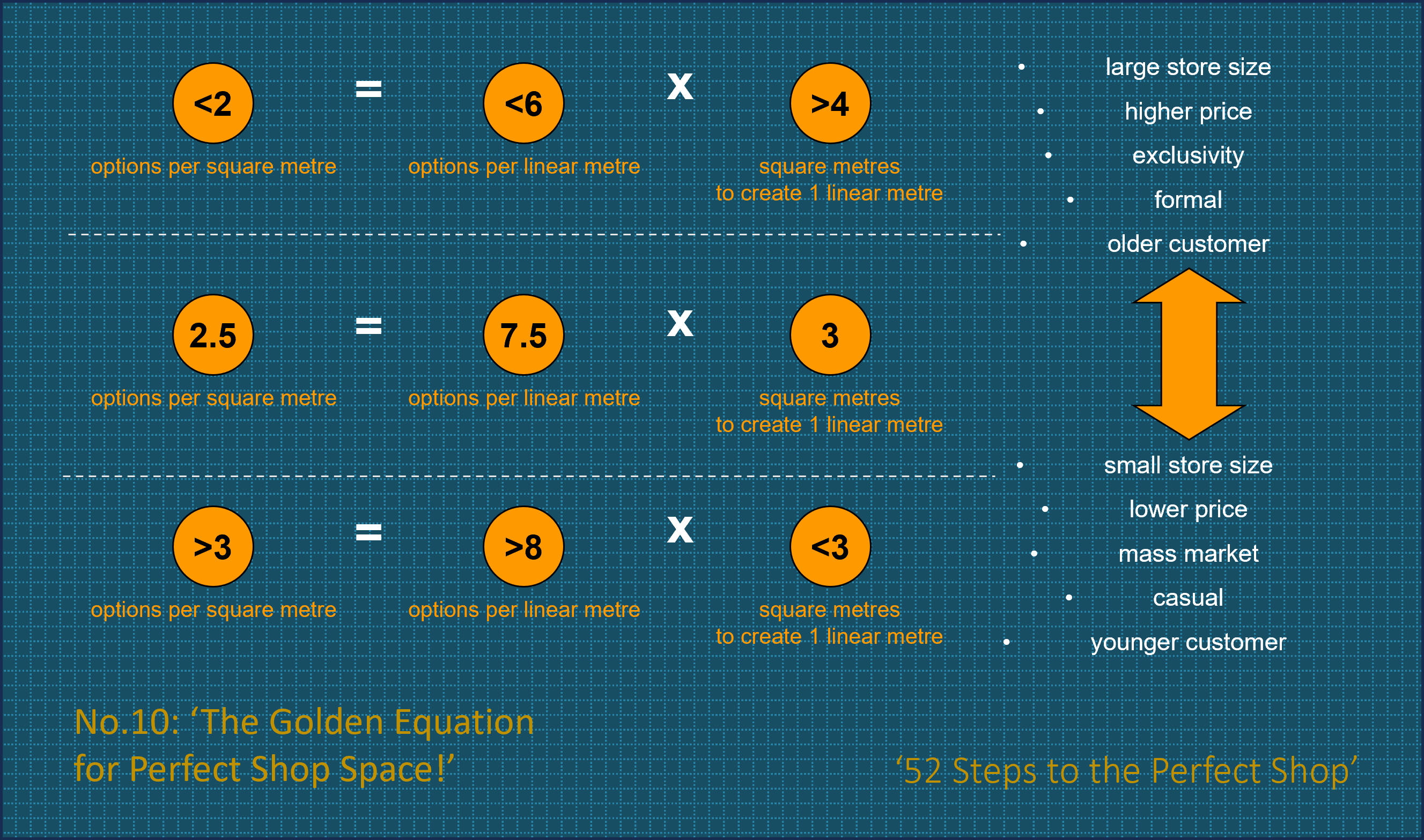Post No.10 in the weekly newsletter series:
‘52 Steps to the Perfect Shop!’
You too can have ‘The Perfect Shop’ by this time next year!
It is often said when writing music that it is not the notes that make the song, it is the spaces in-between.
Similarly when it comes to shop space planning, it could be argued that the perfect brand environment is not made by the linear metre blocks, it is created by the space in-between.
It is ‘the square metres to linear metres conversion rate’ that creates the shop space for the brand environment. It is an important number that is is rarely considered.
However, ‘the sqm to lnm conversion rate’ is a number that both defines and is defined by the options/sqm and options/lnm values. The three values form an important space planning equation.
Welcome to the Space Planning Golden Equation:
Options/sqm = Options/lnm x Sqm/Lnm conversion rate.
As we have learnt, the options/sqm must be set correctly for a shop to be commercial, so it has enough product to generate sales to cover costs and make profit, but not too much so as to inhibit the customer from shopping – the rate of sale.
For any shop, this value is not for changing, or you jeopardize the viability of the shop.
It is the balance between the options/lnm, and the sqm/lnm conversion rate that is the fascinating relationship. Both are numerical values yet are totally qualitative in their impact.
The options per linear metre define the volume of options on display, the options in each ‘product story block’, and so the visual impact and storytelling. The sqm/lnm conversion rate defines the volume of empty space, and so the opportunities for brand environments.
Buyers & merchandisers work with options/sqm. Visual merchandisers work with options/lnm. Shop designers work with sqm/lnm conversions.
So for any specific shop you can play with the balance of options/lnm and the sqm/lnm conversion. In a nutshell there is a direct relationship between the two. If you increase free space you need more options/lnm. If you want to keep options/lnm low then you will need to sacrifice some brand space.
One scenario you may face, is to be able to put enough options into a shop because you only have limited wall space linear metres but you don’t want to display too dense story blocks. You need more linear metres, so you add in new walls, or high fixtures so both options/lnm and options/sqm are both good.
Conversely in an irregular shop you may have walls everywhere and too many linear metres. It means your options/sqm is too high. So you use more of the shop space for brand experience and reduce the linear metres and sqm/lnm conversion.
And if you get to shop grading, when you have several shops or more, you may even want to increase options/sqm in a small but very busy shop. Increasing walls, adding in more floor fixtures may be required to increase linear metres but protect displays.
The important thing with finding the correct balance of values is to protect the options/linear metre, because this value is what you used to plan, buy for, and create your linear metre ‘Product Story Blocks.’ Protect your ‘Product Story Blocks’ as a priority.
The red line that you must not cross, when you play with values for whatever space or strategic reason, is that the equation must still work. The values must still add-up! You cannot alter any value without effecting the others. This is when your shop will descend into visual & commercial chaos.
Clearly managing the qualitative and quantitative elements of shop planning is quite complex. Buyers & merchandisers, visual merchandisers and shop designers must all work with specific values that all combine together.
This is why space planning, and often a space planner, is essential for the delivery of your perfect shop, whether it is your first and only, or one of many.
’52 Steps to the Perfect Shop!’
For everyone looking to improve their physical shops, or thinking of opening their first pop-up or permanent shop.
The weekly newsletters, and the 10 content modules they feature, have been created from my experiences of opening hundreds of shops, of all different sizes, situated across the world, selling just about everything there is to sell.
Every week we explore the sequential process of physical shop development to help you deliver your perfect shop.
Missed any of the previous ’52 Steps’ then just click here to catch up…
